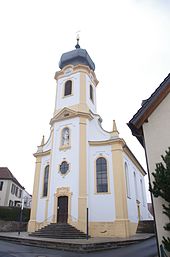Theilheim (Waigolshausen)
|
Theilheim
community Waigolshausen
Coordinates: 49 ° 56 ′ 36 ″ N , 10 ° 8 ′ 52 ″ E
|
|
|---|---|
| Height : | 247 m |
| Area : | 7.14 km² |
| Residents : | 750 |
| Population density : | 105 inhabitants / km² |
| Incorporation : | May 1, 1978 |
| Postal code : | 97534 |
| Area code : | 09384 |
Theilheim is a district of the municipality Waigolshausen in the Lower Franconian district of Schweinfurt in Bavaria .
Geographical location
Theilheim is located in a valley surrounded by regular heights near the river Main between the cities of Würzburg and Schweinfurt . The hamlet of Dächheim is also in the Theilheim district .
history
Theilheim was founded around 600 during the Frankish conquest . Its name probably comes from a Frankish noble named Tailo or Tagilo . But it could also come from Theilheim's location, i.e. Heim im Tal . Different spellings of the place name are documented:
- Tele (1094)
- Taleheim (1148, 1167, 1203)
- Telheim (1300, 1313)
- Deilheim (1337)
- Klein Thelheim (1402)
- Teylheim (1430)
The first documentary mention was made on September 2, 1094 in a deed of donation from Count Palatine Botho of Carinthia to the Theres Monastery .
On May 1, 1978 Theilheim was incorporated into the municipality of Waigolshausen.
Special structures
see also: List of architectural monuments in Waigolshausen # Theilheim
church
The first church in Theilheim was consecrated in 1477. It was 16 meters long and 6 meters wide and was dedicated to all saints. In 1612 a real tower was built. The last service before the demolition of the old church was held on April 11, 1758.
The new church is built in the Rococo style. The foundation stone was laid on April 27, 1758 according to the plans of Johann Michael Fischer (master builder) from the school of master builder Balthasar Neumann . The font from 1600 comes from the old church.
lock
The Theilheimer Schloss was built in 1741 by Karl Heinrich Freiherr von Erthal . After the secularization of 1802 the owners of the castle changed several times.
synagogue
The construction of the first synagogue was approved in 1732. The new synagogue was built around 1850. She fell victim to arson during the Night of the Reichspogroms in 1938. The interior of the building, seven Torah scrolls and the entire archive of the Jewish community were destroyed.
Viticulture
Theilheim is today a wine-growing area in the Franconian wine-growing region . A vineyard exists around the village, the wine has been marketed together with Hergolshausen under the name Theilheimer Mainleite since the 1970s. Theilheim is part of the range Volkacher Main loop until 2017, the wineries in area were Maindreieck summarized. The limestone soils around Theilheim are also suitable for growing wine, as is the location in the Maingau climate zone, which is one of the warmest in Germany.
The people around Theilheim have been cultivating wine since the early Middle Ages . The Franconian settlers probably brought the vine to the Main in the 7th century. In the Middle Ages, the region was part of the largest contiguous wine-growing region in the Holy Roman Empire. The people mostly operated part-time viticulture for self-sufficiency , at the same time export centers were already emerging, especially along the Main. Theilheim was one of the larger wine-growing towns at this time, and many documents prove the connection with viticulture.
Viticulture experienced a major decline after secularization at the beginning of the 19th century. Above all, locations with less favorable climatic conditions were completely abandoned. In addition, the emergence of pests such as phylloxera made cultivation difficult . The Franconian wine-growing region was not able to consolidate again until the second half of the 20th century. The use of fertilizers and improved cultivation methods had contributed to this, as had the organization in cooperatives and the land consolidation of the 1970s. Today three winemakers from Theilheim cultivate the vineyards.
| Vineyard | Size 1993 | Size 2017 | Compass direction | Slope | Main grape varieties | Great location |
|---|---|---|---|---|---|---|
| Main line | 18 ha | 13 ha | South, southeast | 15-30% | Bacchus , Müller-Thurgau | Volkacher Kirchberg |
Personalities
- Mendel Rosenbaum (1782–1868) was a rabbi .
literature
- Hans Ambrosi, Bernhard Breuer: German Vinothek: Franconia. Guide to the vineyards, winegrowers and their kitchens . Herford 2 1993.
- “900 years of Theilheim with Dächheim” - Working group on local history in the festival community “900 years of Theilheim” - Franconian company printing and publishing company GmbH, Würzburg, 1994
Web links
Individual evidence
- ^ Federal Statistical Office (ed.): Historical municipality directory for the Federal Republic of Germany. Name, border and key number changes in municipalities, counties and administrative districts from May 27, 1970 to December 31, 1982 . W. Kohlhammer GmbH, Stuttgart and Mainz 1983, ISBN 3-17-003263-1 , p. 754 .
- ^ Ambrosi, Hans (among others): German Vinothek: Franconia . Pp. 50-52.
- ^ Government of Lower Franconia: Vineyards in Bavaria broken down by area , PDF file, accessed on May 16, 2019.
- ^ Ambrosi, Hans (among others): German Vinothek: Franconia . P. 237.



